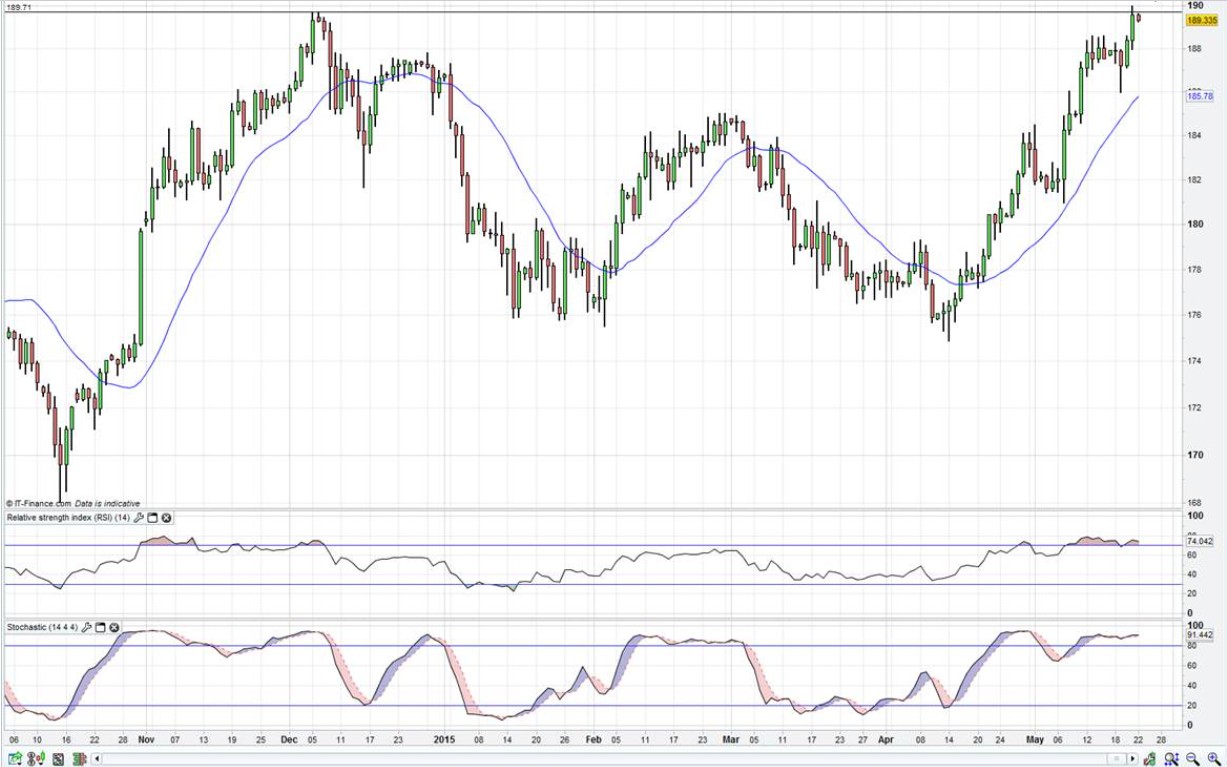Chris Weston, Chief Market Strategist at IG Markets
Volatility in the equity markets has fallen off a cliff today, with tight ranges seen in Australian and Japanese markets. China, however, has put on a further 2% (on massive volume) and continues to soldier on as unused funds from recent IPO’s have been repositioned back into the domestic market.
Current conditions dictate that it pays to be selective, with Japan, China and US markets grinding higher. European markets are also looking more compelling and I still like the idea of European outperformance relative to that of the US this year, although that will of course depend on German bund volatility falling away. Clearly, the calming words from the European Central Bank’s Benoit Coeure earlier in the week, to front-load the central banks bond buying program was coordinated with other key officials in such a way to lower the volatility in the bund market. This seems to have worked somewhat and given confidence to the equity bulls.
It feels that central banks generally don’t have too much of an issue with yields rising, especially when 25% of Eurozone bonds still have negative yields. Bear in mind this figure was closer to 40% a month ago. However, it’s the volatility that makes life so hard for funds and investors to deal with, especially if you look at some of the moves in yield on a percentage basis. The traders naturally have a field day in these conditions, however it seems the calming influences from key central bankers has arrested some of the rampant selling and perhaps the reality is bond markets are more closely aligned to economic reality than where they were.
Equity investors are happy putting money to work as long as bond yields are moving sideways or even better; lower. The VIX index (also known as the US volatility index) is testing the year’s lows at 12.11% and is now some 33% below the five-year average. It’s no coincidence then that we are back to hearing the repetitive calls of the S&P 500 making a new all-time high.
With the ECB forum underway, we get an absolute central banker’s talk-fest in European trade with traders having to contend with rhetoric from Draghi, Bank of England Governor Carney and Head of the Bank of Japan, Kuroda. A few hours later (03:00 AEST) Janet Yellen speaks from Rhode Island the lack of portfolio protection suggests traders and investors see these bankers offering little to rock risk appetite.
As mentioned, volatility in Australian equities has also fallen today, although implied volatility remains flat on the week. Health care stocks have outperformed of late, but today we’ve seen better buying in the industrial and utility space. Banks have seen modest downside on the session and remain in ‘correction’ territory, with the financial sub-sector having fallen 11% from 23 March. The price action doesn’t have the feel of a sharp snapback anytime soon, but I wouldn’t be shorting these names right now at these levels either.
The ASX 200 continues to trade at strong valuation premium to the longer-term average at 16.6 times consensus 12-month average. So, a move back to a multiple of 14.5 would pose much more significant value. To get there, the 200-day moving average at 5,582 has contained the selling this week and a sustained move through here would open up a deeper move into the January lows of 5300. On the upside, a move through 5747 to 5751 (the 15 May high and 38.2% retracement of the April to May sell-off) would present itself as a more bullish development and suggest increasing short-term positioning to Australian equities.
In the forex space, the USD has pushed 2.5% higher on the week, predominately against the EUR and Scandinavian currencies. Lacklustre data has seen long-term US rates fall a touch, taking some of the wind out of the USD’s sails. The premium US treasuries command over other bond markets remains the dominant FX driver, so we shall have to watch how bond yields trade on Janet Yellen’s insights.
There are some good looking momentum set-up’s at present, but I expect traders to increase short positioning on a closing break of the 25 January pivot low of $1.1097. Look for a move to $1.0881 on this development.
USD/JPY has pulled back a touch on today’s Bank of Japan statement, although the fact the central bank have upgraded their economic assessment should not surprise anyone. USD/JPY looks like a buy into ¥120.50, with a stop below ¥119.80. However, this is now driven predominately by the USD side of the equation, so I would keep position sizing small until (or if) we see a break of the recent high of ¥122. Traders are also eyeing a break of the ¥190 double top in GBP/JPY, so that’s another pair to keep on the radar.

It’s fairly clear to me that the BoJ are content and therefore the likelihood of additional easing is limited. Still, we need to remember that the bank is expanding its balance sheet at a very aggressive rate and buying around 90% of all bonds issued by the government. It’s hard to see this ending well, but for now the fact that we are still debating a tightening of policy from the Federal Reserve policy and Bank of England should support GBP/JPY and USD/JPY.
Ahead of the European open we are calling the FTSE 7020 +7, DAX 11874 +10, CAC 5152 +6, IBEX 11604 +9 and MIB 23765 +26